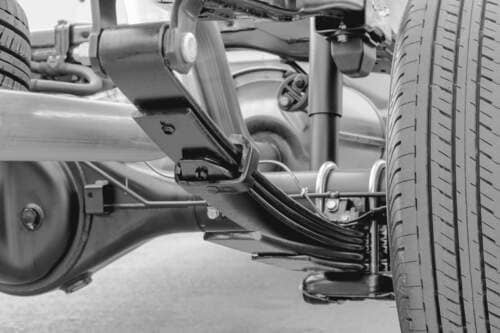A good suspension system on a car enables a comfortable ride even on bad roads with lots of bumps. But what should you do if the suspension is defective or even broken? Here we will provide you with answers and information.

What is the function of the car's suspension?
The suspension is part of the chassis and ensures that the wheels adapt to the irregularities of the road to guarantee an even grip. This way the driver, passengers, and vehicle load are protected from unpleasant vibrations and shocks. Without appropriate suspension, this could lead to serious damage to your health, especially to the spine. Therefore, together with the shock absorbers, the chassis springs are essential for both driving comfort and safety.
Different suspension systems
Leaf springs were installed in the first automobiles, as was the case with carriages. In modern vehicles, however, coil springs or spiral springs have largely prevailed due to their inexpensive production and maintenance. Air springs or gas springs are rarely used in cars. Pneumatic, hydraulic, and electric springs, in which an electric motor returns the wheel to its original position, are also possible, but also rather rare or not yet ready for series production.

How does the car suspension work?
Suspensions for passenger cars are usually spiral or coil-shaped. They absorb kinetic energy and convert it into a reduced vibration. This happens when the spring bends and then moves back to its original position with the help of its spring force. This creates kinetic energy, which is converted into heat through compression and friction. The shock absorber helps with the conversion and shortens the time until the spring returns to its original position.
Causes for broken suspension springs
The most common causes of broken or defective suspension springs are poor road surfaces or driving over high kerbs at high speed. In particular, slightly older suspension springs, which have already experienced the effect of material fatigue, break quickly under such high loads. Frequently driving over high kerbs also puts considerable stress on the chassis springs. This is one of the main reasons why front right springs break most frequently. As soon as a crack develops in the suspension spring due to the high load, this can promote the formation of rust. If the material is weakened so much at some point, the spring may break while driving. This often results in an audible cracking sound or a jolt in the steering wheel. In rare cases, the breakage remains unnoticed while driving.
When should a suspension spring be replaced?
You are most likely to notice a broken suspension spring by “spongy” steering and rattling noises. Since the suspension springs are covered by the wheels, this usually makes it difficult to inspect them. The easiest way to check is, of course, on a lifting platform. Common signs of a broken spring are noises such as squeaking and creaking. If a suspension spring is broken, this does not pose an immediate danger. Continuing to drive is therefore quite possible, although the driving comfort is clearly impaired. In addition, the shock absorber is overloaded, resulting in high wear and tear because it is no longer supported by the broken suspension spring. For this reason, we don’t recommend to continue driving with a broken suspension spring.
What should be considered when changing the suspension?
Even if only one spring is broken, we suggest always having both springs replaced in pairs on one axle, as the spring effect changes in the long run, and the new and old springs would have different tensions. Therefore, a one-sided replacement would negatively affect the suspension characteristics and handling. Furthermore, the new springs should match the installed shock absorbers.

Tips for preventing a broken spring
- Do not overload the car. As soon as a vehicle is overloaded, this causes damage to shock absorbers, suspension springs, and suspension, as the vibrations that occur when driving on bad roads will be amplified.
- Avoid aggressive driving. Shock loads caused, for example, by driving quickly over a bump or kerb have a considerable effect on the chassis springs and other suspension elements.
- Defective suspension ball joints or rear and front shock absorbers must be replaced in a timely manner because driving with worn shock absorbers, for example, can lead to broken springs.
Conclusion
In summary, it remains to be mentioned that suspension springs are of great importance for both driving safety and comfort. Due to their length, they also influence the appearance of the vehicle. Lowering the car, for example, also has a positive effect on cornering speed. However, in the case of corresponding conversions with shorter sports springs, care should also be taken to adjust the shock absorbers. When replacing broken suspension springs, always have them replaced in pairs on one axle, even if only one spring is affected.
TOP products on the subject:










































